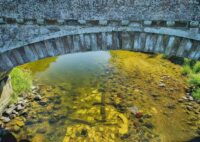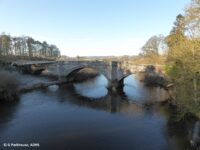 The remains of a medieval bridge over the River Teviot near Ancrum in the Scottish Borders have been discovered under the spans of the 18th bridge that eclipsed it. The bridge had fallen down the memory hole after the construction of the 1784 Toll Bridge, known as Ancrum Old Bridge today to contrast it with the Trunk Road bridge built in 1939. Its existence was rediscovered in 2018 by members of the Ancrum and District Heritage Society (ADHS), a local volunteer archaeology group, who came across a reference to it in the minutes of a council meeting from 1674. A little more research found it marked on a 1654 map, and volunteers hit the Teviot riverbank with a drone looking for any traces of the medieval bridge. A stone platform with an embedded timber was captured in one of the drone’s aerial photographs.
The remains of a medieval bridge over the River Teviot near Ancrum in the Scottish Borders have been discovered under the spans of the 18th bridge that eclipsed it. The bridge had fallen down the memory hole after the construction of the 1784 Toll Bridge, known as Ancrum Old Bridge today to contrast it with the Trunk Road bridge built in 1939. Its existence was rediscovered in 2018 by members of the Ancrum and District Heritage Society (ADHS), a local volunteer archaeology group, who came across a reference to it in the minutes of a council meeting from 1674. A little more research found it marked on a 1654 map, and volunteers hit the Teviot riverbank with a drone looking for any traces of the medieval bridge. A stone platform with an embedded timber was captured in one of the drone’s aerial photographs.
With funding from Historic Environment Scotland, ADHS volunteers and experts from Wessex Archaeology surveyed and analyzed the remains. Radiocarbon dating of the timbers confirmed that the bridge was built in the middle of the 14th century. That makes this the oldest set of bridge remains found in their original location in Scotland. Dendrochronologist Dr. Coralie Mills identified the timbers as native oak which is rarely found in Scottish construction after 1450.
Dr Mills said: “The timber structure discovered by ADHS in the River Teviot near Ancrum is a rare survival of part of an early bridge in a hugely strategic historical location. The oak timbers are in remarkably good condition and provide really important local material for tree-ring analysis in a region where few medieval buildings survived the ravages of war….” […]
Dr Bob MacKintosh of Wessex Archaeology Coastal & Marine said: “The results are really exciting. In addition to the surprisingly early date, it seems the foundations were built using branders, a wooden frame laid on the riverbed upon which the courses of stone were placed. This is the first-time branders have been found in an archaeological context in Scotland. They are otherwise only known from historical sources and two accounts of engineering works on extant bridges completed in the 19th and early 20th century.”
 Just 10 miles from the border with England, the bridge connected the abbey and royal castle in Jedburgh to Acrum across the river. From there, trade routes ran to abbeys and castles in Selkirk to the west and Roxburgh and Melrose to the north, so the bridge was vital to the movement of goods and moneys in Scotland. It was maintained by the Augustinian abbey of Jedburgh who profited from the toll fees.
Just 10 miles from the border with England, the bridge connected the abbey and royal castle in Jedburgh to Acrum across the river. From there, trade routes ran to abbeys and castles in Selkirk to the west and Roxburgh and Melrose to the north, so the bridge was vital to the movement of goods and moneys in Scotland. It was maintained by the Augustinian abbey of Jedburgh who profited from the toll fees.
Built during the reigns of David II of Scotland and Edward III of England, the bridge is of historic and strategic national importance. The bridge crossed the River Teviot, carrying the ‘Via Regia’ (The Kings Way), on its way from Edinburgh to Jedburgh and the Border. James V would have crossed here in 1526, as would Mary Queen of Scots returning from her tour of the Borders in 1566, and the Marquis of Montrose on his way to battle at Philiphaugh in 1645.
Come the Scottish Reformation in 1560, the abbey was destroyed and control of the bridge and its toll income shifted to Royal Burgh of Jedburgh. Time, a brisk current and near-constant war left the bridge in increasing disrepair. Numerous attempts were made in the 17th century to get funds to repair the bridge (that’s what a lot of those town council minutes were about), but they came to naught and by 1698 the bridge was no longer useable. It took nearly a century for it to be replaced by what is now Ancrum Old Bridge.